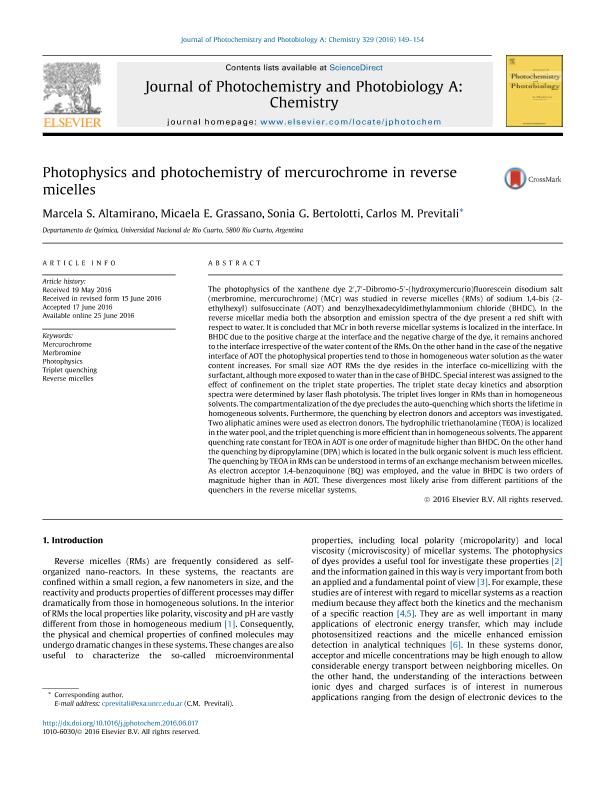Mostrar el registro sencillo del ítem
dc.contributor.author
Altamirano, Marcela Susana

dc.contributor.author
Grassano, Micaela Estefania

dc.contributor.author
Bertolotti, Sonia Graciela

dc.contributor.author
Previtali, Carlos Mario

dc.date.available
2022-12-01T14:13:51Z
dc.date.issued
2016-06
dc.identifier.citation
Altamirano, Marcela Susana; Grassano, Micaela Estefania; Bertolotti, Sonia Graciela; Previtali, Carlos Mario; Photophysics and photochemistry of mercurochrome in reverse micelles; Elsevier Science SA; Journal of Photochemistry and Photobiology A: Chemistry; 329; 6-2016; 149-154
dc.identifier.issn
1010-6030
dc.identifier.uri
http://hdl.handle.net/11336/179786
dc.description.abstract
The photophysics of the xanthene dye 2′,7′-Dibromo-5′-(hydroxymercurio)fluorescein disodium salt (merbromine, mercurochrome) (MCr) was studied in reverse micelles (RMs) of sodium 1,4-bis (2-ethylhexyl) sulfosuccinate (AOT) and benzylhexadecyldimethylammonium chloride (BHDC). In the reverse micellar media both the absorption and emission spectra of the dye present a red shift with respect to water. It is concluded that MCr in both reverse micellar systems is localized in the interface. In BHDC due to the positive charge at the interface and the negative charge of the dye, it remains anchored to the interface irrespective of the water content of the RMs. On the other hand in the case of the negative interface of AOT the photophysical properties tend to those in homogeneous water solution as the water content increases. For small size AOT RMs the dye resides in the interface co-micellizing with the surfactant, although more exposed to water than in the case of BHDC. Special interest was assigned to the effect of confinement on the triplet state properties. The triplet state decay kinetics and absorption spectra were determined by laser flash photolysis. The triplet lives longer in RMs than in homogeneous solvents. The compartmentalization of the dye precludes the auto-quenching which shorts the lifetime in homogeneous solvents. Furthermore, the quenching by electron donors and acceptors was investigated. Two aliphatic amines were used as electron donors. The hydrophilic triethanolamine (TEOA) is localized in the water pool, and the triplet quenching is more efficient than in homogeneous solvents. The apparent quenching rate constant for TEOA in AOT is one order of magnitude higher than BHDC. On the other hand the quenching by dipropylamine (DPA) which is located in the bulk organic solvent is much less efficient. The quenching by TEOA in RMs can be understood in terms of an exchange mechanism between micelles. As electron acceptor 1,4-benzoquinone (BQ) was employed, and the value in BHDC is two orders of magnitude higher than in AOT. These divergences most likely arise from different partitions of the quenchers in the reverse micellar systems.
dc.format
application/pdf
dc.language.iso
eng
dc.publisher
Elsevier Science SA

dc.rights
info:eu-repo/semantics/openAccess
dc.rights.uri
https://creativecommons.org/licenses/by-nc-sa/2.5/ar/
dc.subject
MERBROMINE
dc.subject
MERCUROCHROME
dc.subject
PHOTOPHYSICS
dc.subject
REVERSE MICELLES
dc.subject
TRIPLET QUENCHING
dc.subject.classification
Otras Ciencias Químicas

dc.subject.classification
Ciencias Químicas

dc.subject.classification
CIENCIAS NATURALES Y EXACTAS

dc.title
Photophysics and photochemistry of mercurochrome in reverse micelles
dc.type
info:eu-repo/semantics/article
dc.type
info:ar-repo/semantics/artículo
dc.type
info:eu-repo/semantics/publishedVersion
dc.date.updated
2022-11-30T22:34:15Z
dc.journal.volume
329
dc.journal.pagination
149-154
dc.journal.pais
Países Bajos

dc.journal.ciudad
Amsterdam
dc.description.fil
Fil: Altamirano, Marcela Susana. Universidad Nacional de Río Cuarto. Facultad de Ciencias Exactas Fisicoquímicas y Naturales; Argentina
dc.description.fil
Fil: Grassano, Micaela Estefania. Universidad Nacional de Río Cuarto. Facultad de Ciencias Exactas Fisicoquímicas y Naturales; Argentina. Consejo Nacional de Investigaciones Científicas y Técnicas. Centro Científico Tecnológico Conicet - Córdoba; Argentina
dc.description.fil
Fil: Bertolotti, Sonia Graciela. Universidad Nacional de Río Cuarto. Facultad de Ciencias Exactas Fisicoquímicas y Naturales; Argentina. Consejo Nacional de Investigaciones Científicas y Técnicas. Centro Científico Tecnológico Conicet - Córdoba; Argentina
dc.description.fil
Fil: Previtali, Carlos Mario. Universidad Nacional de Río Cuarto. Facultad de Ciencias Exactas Fisicoquímicas y Naturales; Argentina. Consejo Nacional de Investigaciones Científicas y Técnicas. Centro Científico Tecnológico Conicet - Córdoba; Argentina
dc.journal.title
Journal of Photochemistry and Photobiology A: Chemistry

dc.relation.alternativeid
info:eu-repo/semantics/altIdentifier/url/https://www.sciencedirect.com/science/article/pii/S1010603016303896
dc.relation.alternativeid
info:eu-repo/semantics/altIdentifier/doi/http://dx.doi.org/10.1016/j.jphotochem.2016.06.017
Archivos asociados
